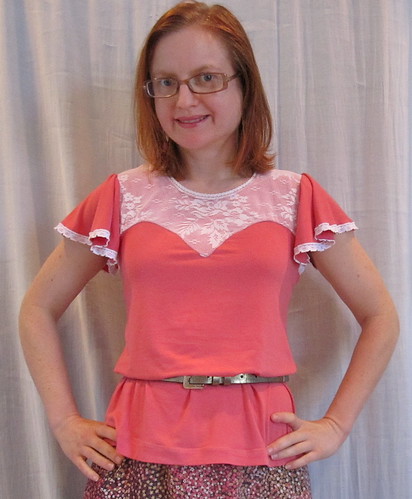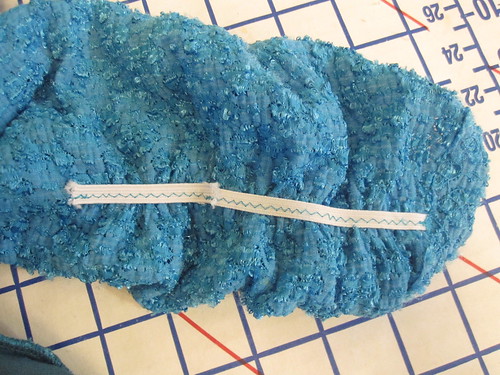
I should have made clear in my last post that I had actually already drafted and sewn the final pattern when I posted about my muslin, before there was a consensus (and confirmation, as seen below) that there *are* seams in the front. But, alas, I was still in the dark and drafted the front as one piece.
Both Nancy K and Loti asked about draping. I don't know how to drape and though it would be an awesome skill to have, I just don't have enough free time to learn. :( I have only a few hours a week to sew and I would miss general workaday sewing too much to devote that time for months (or longer) to learning how to drape just to do a few projects a year. Also, flat pattern works better with my non-3D mind. I would never be able to unpin a draped project from a dress form and figure out what the heck I did!
After my first couple of muslins, I decided to try to be a little scientific. Plus, making full sized patterns was getting really old! So I played some paper dolls. I drew a little front bodice and then traced it several times. I slashed and spread it in different ways to see how that affected things.

The interesting thing to me was how similar--not how different--the patterns ended up looking, even though they were slashed in different places. I decided to go with #2 for my final pattern, as it seemed like the most volume for the least side seam distortion.
I had learned from Muslin 2.1 that all the effort I had put into fitting the waist of my master pattern while still leaving it pull-on-able had been pretty much wasted. I needed the extra width along the waistline to make room for the faux wrappy thing. So in addition to slashing and spreading, I flattened the waistline curve in the front piece and reduced it a bit (but not fully flattened) on the back. I also lowered the seam for the hip band, as I originally had it too high.

I believe the Grandie is fully lined, but for a silk summer top I thought a lining would make it too hot. Not to mention, it would look best self-lined and I didn't have enough fabric. I used a really lovely quality silk crepe from The Carol Collection. I wasn't crazy about this fabric until I prewashed it (by hand in the sink) and then it revealed itself to be quite spectacular.
Rather than separate neckline and armscye finishes, I decided that an all-in-one facing was needed to ensure the top kept its shape.
To nicely finish the edges of the facing, I used Sunny Gal's interfacing trick. Sew the lower edge of the interfacing and fabric, right sides together--so that the interfacing "glue" side is up. Trim, if you didn't use a serger. Then turn the interfacing up to the wrong side of the facing and fuse the interfacing in place. The lower edge is neatly turned up without extra bulk. It's a bit tricky to get a nice smooth edge over curves because you can't press it in place until you're ready to fuse, but a little bobble here and there is still nicer than a sergerd or zigzagged edge.
Although I have read several tutorials on sewing an all-in-one facing by machine without a CB seam (something like the burrito method for yokes), I really didn't want to add figuring that process out to this already frustrating project, so I kept the CB seam in my top and used my all-machine clean-finish technique.

The hip band is also self-lined. To keep the hem stable and add a little weight I interfaced the lower edge of the facing piece. I didn't want the look of topstitching in this project so rather than do my usual method of sewing the facing to the wrong side, sewing the fashion fabric to the hem of the facing, and then topstitching the upper edge of the fashion fabric in place, I did this the traditional way and hand-stitched the band facing to the upper seam allowance.

I generally like to use French seams on silk, but with all the layers it would have been bulky in places. So I did regular seams at the shoulders and the side seams of the band--seams that are hidden inside facings. The only French seams are the side seams of the upper bodice. When including a tie in a French seam, remember that it must be included in the first pass!

You want the tie to end up on the outside. On the first "wrong side to wrong side" pass, the right side of the fabric is on the outside. So the tie goes on the outside too. When the top is turned inside out and the "right side to right side" pass is made, the end of the tie gets sandwiched into the seam and the tie ends up on the outside. (It always takes me great mental effort to figure these things out.)
The most difficult part on the final product was figuring out where to place the pleats and front tie. I'm not sure I chose correctly, but it cannot be undone now without destroying the fabric so c'est la vie!

I tried on the top and pinned the pleats in place. Then I machine stitched vertically over the pleats.

Next, I took the tie and stitched it, with the end flush to the pleats, so the finished end of the tie was reaching toward the side on which it would be tied (sorry for my bad technical writing).

Once it was stitched in place, I flipped the tie over to the other side and stitched again, enclosing that raw edge. When the tie is pulled over to be tied, the seam is hidden.
Alas, I did not crack the Grandie code. I was hoping this would be a pattern I could use again with sleeves for Fall/Winter but I am not crazy about the final result. Rather than cascading and draping, I just have a big bulge of fabric over the left side of my bust.
Sunny Optimist geniusly found this photo online where the seller had tied the top the "wrong" way, clearly exposing the seams. Well, that would have been helpful! With this information it would be a lot simpler to draft a closer approximation; I'm not sure I have the stomach to go back to this project.


However, although it wasn't fully successful, it was still a highly educational project. I learned a *lot* about pattern manipulation, and I can imagine all sorts of other patterns that can be drafted using this method. And plus, the paper dolls are so much fun and no risk/cost in materials (I use scrap paper).
All photos are here and the pattern review is here.











































.jpg)








































































.jpg)















